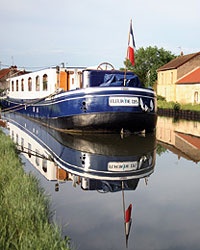 Courtesy of Orient-Express
From cozy canal barges in France to five-star floating hotels in China, river cruising is more popular than ever.
Courtesy of Orient-Express
From cozy canal barges in France to five-star floating hotels in China, river cruising is more popular than ever.
See our slideshow of 10 River Cruises to Remember.
A mirage vibrates on the sandy horizon. The scent of African roses perfumes the air. Water buffalo grunt and graze on the grassy banks of the Nile as ancient Pyramids cast their shadows. These may be the scene-setting details of a typical afternoon aboard Cleopatra's royal barge, but they’re not so different from Nile river cruises today.
Wherever you travel—Egypt, Europe, China, the U.S.—cruising on rivers and canals may well be one of the last leisurely modes of transportation. Beyond the inviting languid afternoons that pass by at 5 mph, this millennia-old form of cruising guarantees a taste of the local culture, and an up-close view of gorgeous meandering landscapes studded with vineyards, castles, and scenic villages. For these reasons and more, river cruising is rising in popularity, with Europe bookings alone quadrupling since 1998.
Fall happens to be a particularly good time of year to hit the rivers. In France, Germany, and California’s Napa Valley, grape harvests are in full swing; in some places, like France’s Champagne region, you will witness armies of workers with shears picking fruit from carefully cultivated rows of vines. October, and late September, too, is the season for Germany's biggest party, Munich’s Oktoberfest, where breweries set up massive tents and ply millions of revelers with their hoppy products. (Danube cruises often depart from Passau, less than two hours from Munich.) On fall cruises here in the United States, the spectacular colors of the turning leaves provide a natural show. And in the popular cruising areas of Russia, China, and Egypt, autumn brings weather that's neither too hot nor too cold—an ideal time to travel.
River ships and barges are akin to floating hotels; they take you on the calm, inland waterways and lead you to places inaccessible by car, train, or traditional ocean cruise. And as with ocean cruising, a river cruise is an easy travel experience—your accommodations, meals, and in many cases shore excursions are all planned for you. You visit several places but have to unpack only once.
On the rivers, speedy travel is never the goal—these are the original “slow boats.” In France, for instance, the tiny barges of French Country Waterways move so slowly through the many locks of the historic canals that you can borrow a bike and cycle ahead. If you want time on your own to explore, many itineraries allow for that too. In Germany, Peter Deilmann sailings on the Danube include overnight dockings, so it’s possible to disembark and enjoy the local cuisine, like rich chocolate Sachertorte, where it was invented (at the Hotel Sacher in Vienna).
River ships accommodate as many as 308 passengers but often fewer than 200. Barges carry as few as four passengers, as is the case on the ultra-luxurious Alouette, operated by Afloat in France, where niceties include the finest linens and antiques, not to mention Premier Cru.
Cuisine is hearty and in many cases gourmet, with top-level wine and food particularly emphasized on barges (an excellent choice for foodies). The private chefs onboard the small barges of French Country Waterways, for instance, have French culinary training and are expert at whipping up quail with foie gras, wine-steamed mussels, and other rich dishes. (Warning to those with high cholesterol: bring your pills!)
Casual ambience is the norm, though river cruises are hardly roughing it. Cabins may be on the small side or more spacious—for instance, on the Danube, Peter Deilmann operates the Mozart, whose comfortable cabins are more than 200 square feet. Many ships also have the option of deluxe cabins or suites with balconies. Expect a small number of public rooms—a dining room, a lounge, maybe a separate bar—but plenty of deck space for viewing the sights, and sometimes a small splash pool and gym.
Most river cruise passengers are age 50 and up. Those wanting to travel with a younger set or kids may consider charting an entire barge, as offered by companies including Afloat in France, French Country Waterways, and Abercrombie & Kent.
In the end, river cruising is about gentle, easy exploration—as with Victoria Cruises in China, where decked-out boats thread the Yangtze River locks adjacent to the amazing Three Gorges Dam. Or with Cruise West in the Pacific Northwest, where the fall foliage is soon to be ablaze along the route of Lewis & Clark on the Columbia and Snake rivers, which wend their way by quaint waterside towns, snow-capped mountains, stunning waterfalls, and tall granite cliffs.
On a river cruise you will inevitably gain an appreciation of the area you are visiting, and of the history of riverboat travel. Even if you didn't know that that history might also include water buffalo.